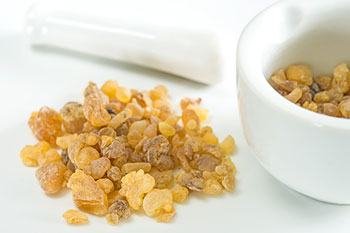
Boswellia Serrata
(bäzˈwelēə səˈrɑːtə) n. 1. East Indian tree (family Burseraceae) of northern Africa and India having triangular 3-celled fruit with winged seed, yielding a resin used in Ayurvedic medicine and burned as incense. Synonyms: Frankicense, Salai, Shallaki, Olibanum Indicum. Derivation: New Latin, perhaps from James Boswell 1795 + New Latin -ia. Ancient Greek λίβανος (líbanos, "frankincense")Source
This herb is a member of the Burseraceae family. Its gum resin extract is used for medicinal purposes related to inflammation. Oleo-gum is the active ingredient and is harvested through an incision in the tree. The tree grows primarily in the mountainous regions of India, Northern Africa and the Middle East. Oleo-gum is comprised of resin, essential oils and water soluble polysaccharides. Boswellia serrata has been used for centuries to treat chronic inflammation. One of its enzymes, boswellic acid is the most potent inhibitor of 5-lipoxygenase, an enzyme responsible for inflammation.Benefits
Although this herb has been used for centuries to treat many maladies, modern medicine and pharmacology strongly point to its use as an anti-inflammatory, anti-arthritic, to control blood lipids, anti-coronary plaque agent, analgesic pain reliever, and to protect the liver.Uses
The number one use of Boswellia serrata is as an anti-inflammatory. It is also used to protect the heart, and liver and to control blood lipids, which are mainly fatty acids and cholesterol. It is also sometimes used in wound healing.Forms (delivery methods)
Boswellia serrata is primarily available in liquid and capsules.Side Effects
Side effects are rare, but could include diarrhea, skin rash and nausea.
Research:
1 Boswellia Serrata, A Potential Antiinflammatory Agent: An Overview
https://www.ncbi.nlm.nih.gov/pmc/articles/PMC3309643/
